

Raspberry Pi Alamode CNC Controller. This is my first attempt at an instructable.
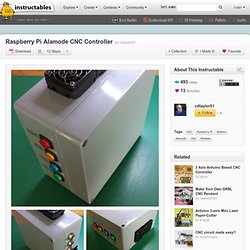
I hope it helps someone else. Switches and Lights and fans, oh my... NEMA 17 Stepper Motor - MakerBot Industries. What is TinyG – and why? – Synthetos. TinyG is a many-axis motion control system.
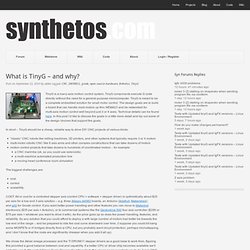
TinyG components execute G code directly without the need for a general-purpose microcomputer. TinyG is meant to be a complete embedded solution for small motor control. The design goals are to build a board that can handle most motors up thru NEMA23 and be networked for multi-axis motion control well beyond just 3 or 4 axes. Technical details can be found here. In this post I’d like to discuss the goals in a little more detail and lay out some of the design choices that support the goals. In short – TinyG should be a cheap, reliable way to drive DIY CNC projects of various kinds: The biggest challenges are: costcontrolscalability COST: All-in cost for a controlled stepper axis (control CPU + software + stepper driver) is optimistically about $25 per axis for a low-end 3 axis solution – e.g. three Allegro A4983 boards, an Arduino (Adafruit, Makershed), and grbl for Gcode control.
Grbl development log. First complete job … completed I finished a little Air-app to stream complete jobs to the Grbl and render the result.
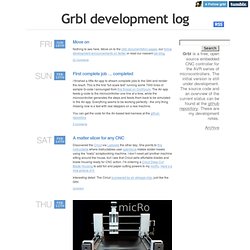
This is the first “full scale test” running some 7000 lines of sample G-code I scrounged from this thread on CncForum. The Air-app feeds g-code to the microcontroller one line at a time, while the microcontroller generates the steps and feeds them back to be simulated in the Air-app. Everything seems to be working perfectly - the only thing missing now is a test with real steppers on a real machine.
You can get the code for the Air-based test-harness at the github-repository Last major feature in place: Helical motion After completing the support for helical motion, the project has reached the point where it is theoretically feature complete. Grbl now uses a simple buffer mechanism to decouple the production of stepper pulses from the computations of steps. Mini CNC. Building a drawer slide CNC machine for under $200!
Drawer Slide CNC Machine for under $200 Like many of us interested in this hobby, I wanted my own machine.
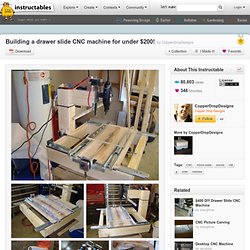
But I didn’t want to dive into it, spend $2k plus and have a large paperweight out in my shop. The idea was born for a simple, cheap, somewhat accurate CNC machine that I could modify as I gained knowledge (and funds). The first step in the process was deciding what hardware I was going to use. I decided on the TB6560-3 axis driver bought off eBay for $22.00/free shipping.
For stepper motors, I found a lot of 5 on eBay for $10.00/free shipping. The spindle is probably the most important part of the machine. There are a lot of misc hardware pieces need to build this machine, but most of which can be found at your local Lowes, Home Depot or local hardware store. Also, you will need some sort of software(and obviously a computer) to run the machine and to do drawings. LinuxCNC.org. MAS 863 - David Carr. My final project is a 3-axis CNC milling machine that costs less than $100 (currently $87) to build.
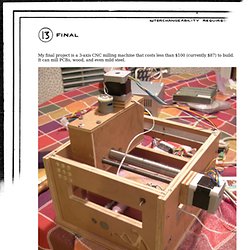
It can mill PCBs, wood, and even mild steel. These PCBs were milled using the machine. The traces are 10-15 mils. The left and lower right boards were milled at approximately the same speed as the Modela. Optical mouse-cam - Optical mouse cam. Are you using an optical mouse right now?
Ever wanted to see your desktop through the eye on the bottom of it? Me neither, I already know I have to clean my desktop :-) People get bored sometimes, and when I get bored I sometimes open up stuff to find out what makes it tick. One time, I did this with an old optical mouse. Well, a mouse only has 2 chips inside: the optical sensor and a chip for the usb/ps2-interfacing. So I start Visual Basic (I usually do my stuff under Linux, but I'm no star at using anything graphical like QT or GTK, so for this quick'n'dirty project I fell back in my old habits) and hack something up using a few wires to the trusty ole parallel port. As you can see, the mouse was over some text with an 'e' in it. One of the more obvious features of a mouse, however, is that it can detect movement.
Optical mouse camera - Bidouille.org. OK, so I finally decided to get my hands on the Arduino platform and see what all the buzz is really about.
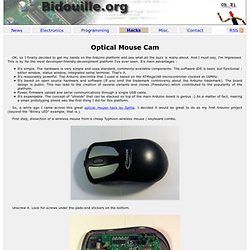
And I must say, I'm impressed. This is by far the most developer-friendly development platform I've ever seen. It's main advantages : It's simple. The hardware is very simple and uses standard, commonly available components. Howie m » Amateur CNC mill show and tell. Friday, November 19, 2010 Amateur CNC mill show and tell Thought I’d have a go at something a bit mechanical for a change.
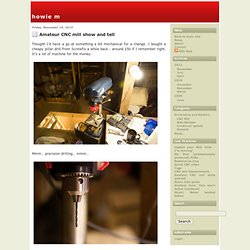
I bought a cheapy pillar drill from Screwfix a while back - around £50 if I remember right. It’s a lot of machine for the money: Mmm… precision drilling… mmm… OK, back to me: CNC mills are all the rage at the moment - loads of people seem to be building them, from huge ones through to tiny little ones you can knock up for very little money. CNC milling machine. While I have understood the basics concept of CNC machining–and have utilized it in my work–I never fully appreciated how complex a system a CNC machine is until I set about designing and building one.

There are many software and hardware layers are involved in the process, and each of these layers offers nearly endless options to choose from… CAM software, controller software, steppers vs. servos and their torque specs, power supplies, motor controllers, breakout boards, encoders, etc. not to mention the mechanical modifications to the manual mill. So as a first step in converting my milling machine to CNC I looked at a lot of other people’s conversions with this and similar machines, especially in the copious posts on CNCzone.com and specifically the great work that “Hoss” has done.